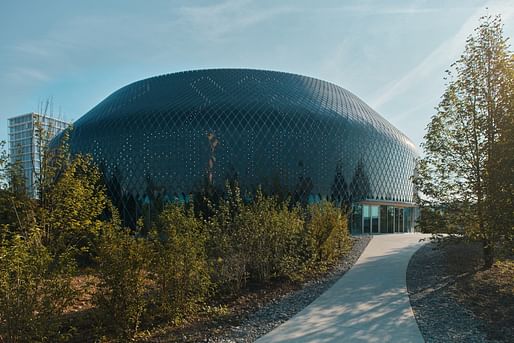
A team comprising iart, AMDL CIRCLE, and Michele De Lucchi has created a ‘zero-energy media façade’ for the Novartis Pavilion in Basel, Switzerland. Combining PV panels and LEDs, the façade is described by the team as “illustrating the potential of organic photovoltaics in architecture.”

The façade features 10,000 diamond-shaped solar modules with LED lights embedded within that shine outwards as well as inwards onto the pavilion’s metal shell. The reflection of the metal shell creates a shimmer through the semi-transparent solar modules, resulting in a multi-layered membrane for displaying content.
The display only consumes as much electrical energy as it is capable of producing through carbon-based organic solar modules that were custom-made for the project. The modules were ideal for the pavilion’s dome shape, due to their bendable, translucent, and highly light-sensitive properties, enabling them to be installed in areas not ideally orientated towards the sun.
“The arrangement of the solar modules on the dome-shaped Novartis Pavillon enables measurement of the electricity produced in all directions,” the team explains. “Data collected during the first few months of operation show that the façade produces enough power to display text in the daytime — when the exhibition is open — and digital art animations for up to two hours after sunset.”
News of the pavilion façade comes in the same week that the Las Vegas Sphere was lit up for the Fourth of July debut, bringing life to what is reportedly the world’s highest-resolution wraparound LED screen.
No Comments
Block this user
Are you sure you want to block this user and hide all related comments throughout the site?
Archinect
This is your first comment on Archinect. Your comment will be visible once approved.